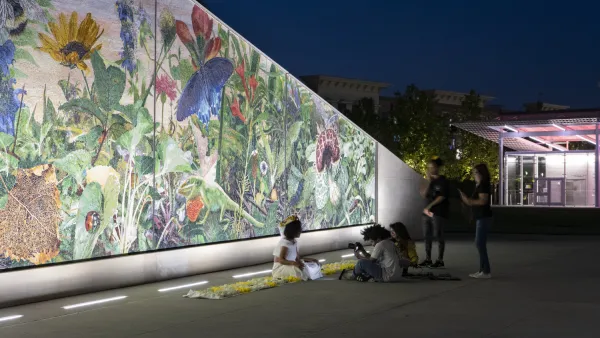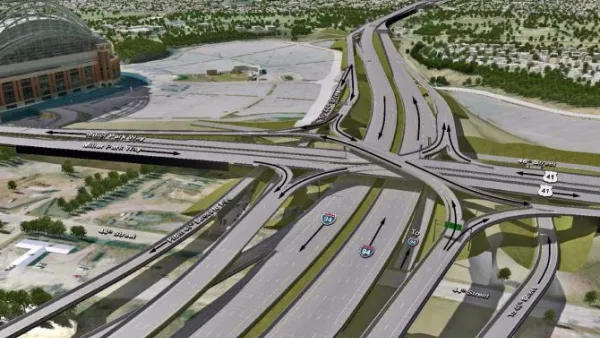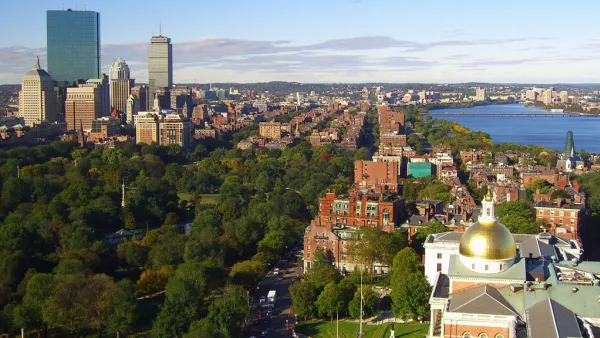A longread, written by Sam Boch and published by Places Journal, has been creating a stir online and is highly recommended for those with an interest in intersections between social justice and urban design.

"Shade is often understood as a luxury amenity, lending calm to courtyards and tree-lined boulevards, cooling and obscuring jewel boxes and glass cubes. But as deadly, hundred-degree heatwaves become commonplace, we have to learn to see shade as a civic resource that is shared by all," writes Sam Bloch.
Shade, according to Bloch, is an index of inequality.
The primary case study for this case is Los Angeles, where the inequality of shade plays out at bus shelters, on the sidewalks, and in the front yards of low-income and minority neighborhoods—enabled by city policies designed for more affluent, suburban neighborhoods and manifested by decades of traffic engineering that prioritizes the fast movement of single-occupant automobiles.
"A few years back, Los Angeles passed sweeping revisions to the general plan meant to encourage residents to walk, bike, and take more buses and trains. But as Angelenos step out of their cars, they are discovering that many streets offer little relief from the oppressive sunshine." What's needed more equally distribute shade, according to Bloch, is a better understanding of shade as a public resource, "a kind of infrastructure."
That understanding runs up against political groups that use shade in a weapon to obstruct new development. "They show up at planning meetings to protest tall buildings that would block views or darken sunbathing decks, and police urge residents in high-crime neighborhoods to cut down trees that hide drug dealing and prostitution. Shade trees are designed out of parks to discourage loitering and turf wars, and designed off streets where traffic engineers demand wide lanes and high visibility."
The article includes a lot of insights offered by experts on Southern California architecture and history, personal and hyper-local anecdotes from neighborhoods around Los Angeles, failed efforts to plant new tress, and the still-nascent progress of more welcoming ideas about shade and urban design influencing even the most high profile urban design projects, like for Pershing Square in Downtown Los Angeles.
One big takeaway from this thorough and exhaustive study bears repeating (and necessitates that planners and urban designers set aside the time to read and re-read this article): "So to the list of environmental injustices in this country, we can add the unequal distribution of shade."
FULL STORY: Shade

National Parks Layoffs Will Cause Communities to Lose Billions
Thousands of essential park workers were laid off this week, just before the busy spring break season.

Retro-silient?: America’s First “Eco-burb,” The Woodlands Turns 50
A master-planned community north of Houston offers lessons on green infrastructure and resilient design, but falls short of its founder’s lofty affordability and walkability goals.

Delivering for America Plan Will Downgrade Mail Service in at Least 49.5 Percent of Zip Codes
Republican and Democrat lawmakers criticize the plan for its disproportionate negative impact on rural communities.

Test News Post 1
This is a summary

Test News Headline 46
Test for the image on the front page.

Balancing Bombs and Butterflies: How the National Guard Protects a Rare Species
The National Guard at Fort Indiantown Gap uses GIS technology and land management strategies to balance military training with conservation efforts, ensuring the survival of the rare eastern regal fritillary butterfly.
Urban Design for Planners 1: Software Tools
This six-course series explores essential urban design concepts using open source software and equips planners with the tools they need to participate fully in the urban design process.
Planning for Universal Design
Learn the tools for implementing Universal Design in planning regulations.
EMC Planning Group, Inc.
Planetizen
Planetizen
Mpact (formerly Rail~Volution)
Great Falls Development Authority, Inc.
HUDs Office of Policy Development and Research
NYU Wagner Graduate School of Public Service





























